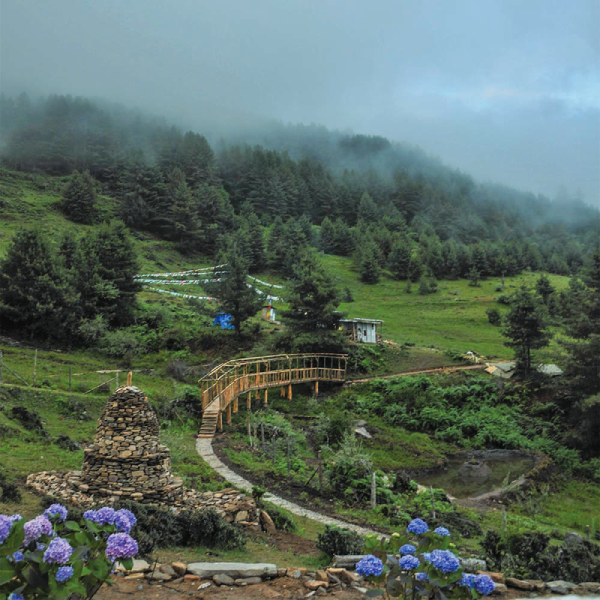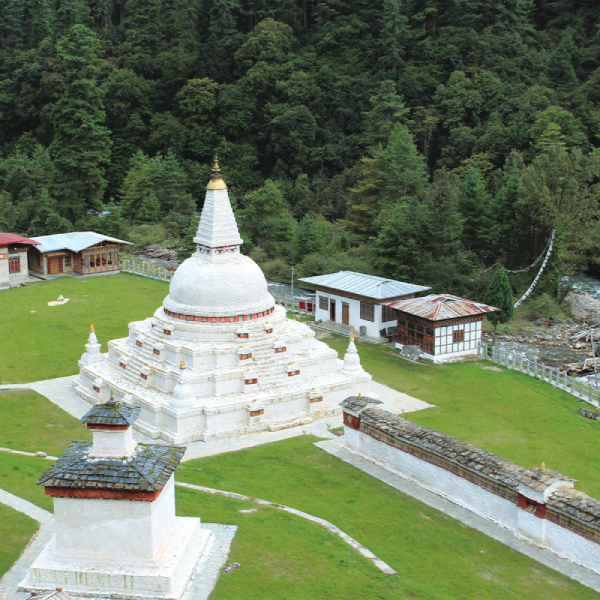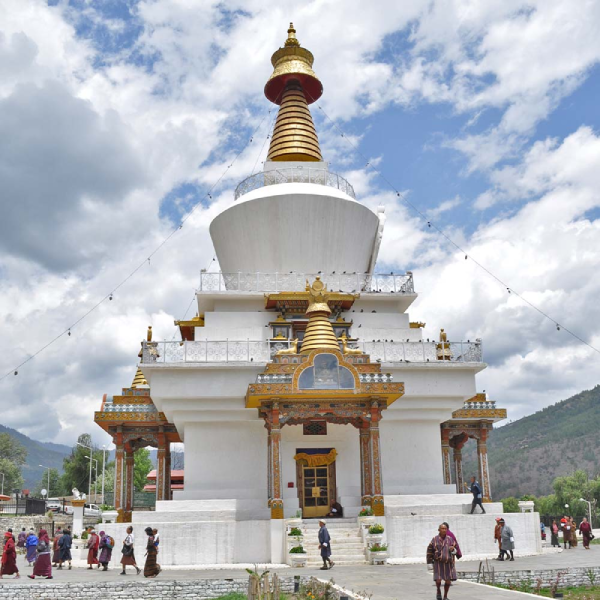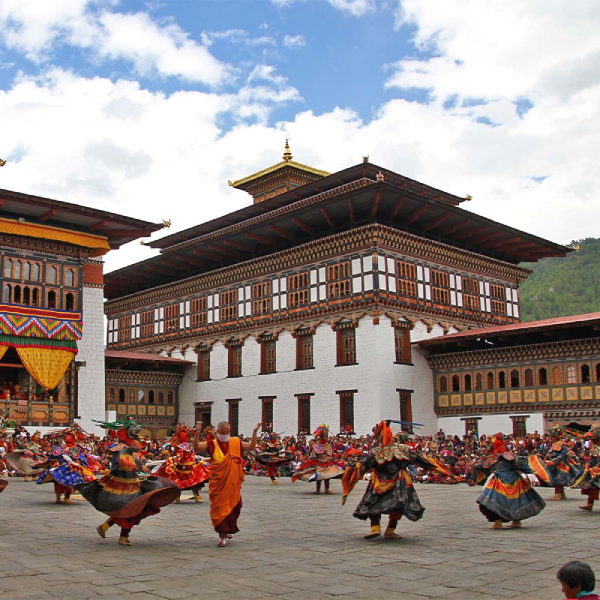Bhutan’s Himalayan Splendours present a breathtaking blend of soaring peaks and rich cultural heritage. Majestic mountains like Gangkhar Puensum and Jomolhari rise with pristine grandeur, their slopes dotted with ancient monasteries and remote hermitages that exude peaceful spirituality. Below, tranquil valleys pulse with the enduring rhythms of Buddhist life, while imposing dzongs such as Paro and Punakha stand proudly as symbols of Bhutanese history and architecture. Exploring Bhutan’s Himalayas offers an unforgettable journey into a land where nature’s magnificence and spiritual traditions coexist in perfect harmony.
“Bhutan’s Himalayan Splendours: A Journey Through Majestic Peaks and Timeless Traditions”
Tours Details
- Home
- Bhutan Tour
- “Bhutan’s Himalayan Splendours: A Journey Through Majestic Peaks and Timeless Traditions”
“Bhutan’s Himalayan Splendours: A Journey Through Majestic Peaks and Timeless Traditions”
Location: Bhutan
Trip: 7Nights 8Days
Max People: 2-15
Duration: 7Nights 8Days
Start Location: Paro
End Location: Paro
Short Itinerary
| Title | Accommodation | Meals |
| Day 01: Arrive at Paro | Hotel | -/L/D |
| Day 02: Thimphu | Hotel | B/L/D |
| Day 03: Thimphu to Trongsa (200 Km, 5-6 Hours) | Lodge | B/L/D |
| Day 04: Trongsa to Bumthang (68 Km, 3-4 Hours) | Lodge | B/L/D |
| Day 05: Bumthang to Punakha (205 Km, 5-6 Hours) | Hotel | B/L/D |
| Day 06: Punakha / Paro (125 Km, 4.1/2 Hours) | Hotel | B/L/D |
| Day 07: Paro | Hotel | B/L/D |
| Day 08: Final Departure | B |
Tour Program
Expand AllYour journey begins high above the Himalayas, where the first rays of dawn illuminate sharp, snowy peaks that stand silent and majestic against the vast morning sky. Below, the vast Himalayan wilderness stretches endlessly, a dramatic stage set for the journey ahead.
As your plane begins its descent, the harsh grandeur of the mountains gradually gives way to a lush, hidden valley. Here, fields quilt the landscape in varying shades of green, punctuated by quaint villages where traditional Bhutanese homes nestle among the hills. Temples with golden roofs peek through the morning mist, whispering tales of centuries past.
Landing in Paro, you are met by crisp, pure mountain air and a sense of calm that seems to embrace you immediately. A friendly local greets you warmly, ready to guide you into this serene kingdom with ease and care.
From here, a winding drive carries you to Thimphu, Bhutan’s peaceful capital. The route meanders through thick pine forests and along glistening rivers, passing prayer flags that flutter gently in the breeze—silent blessings woven into the landscape.
Upon arrival in Thimphu, you settle into your accommodation and begin to feel the rhythm of life here—a quiet blend of ancient tradition and present-day calm. Whether wandering peaceful streets or simply watching the world go by, the city invites you to slow down and connect with the heart of Bhutan.
Hotel
-/L/D
After a restful night and a nourishing breakfast, your day begins with a journey into the vibrant cultural heart of Thimphu—a city where ancient traditions blend seamlessly with a calm, modern rhythm.
National Library
Your first visit is to the National Library, a serene treasure trove of Bhutanese heritage. Here, rows of ancient manuscripts, prayer scrolls carved on wood, and rare religious texts reveal the wisdom preserved through centuries.
Zorig Chusum – The Arts & Crafts School
Next, step into the world of Bhutanese craftsmanship at Zorig Chusum, the country’s renowned arts school. Witness young artisans honing their skills in the thirteen traditional crafts—from delicate thangka painting and intricate wood carving to clay sculpture and fine embroidery—each skill lovingly passed down through generations.
Traditional Medicine Institute
Continue to the Traditional Medicine Institute, where Bhutan’s holistic healing practices come to life. Learn how natural herbs, minerals, and time-honored remedies are still used today to promote balance and wellbeing, embodying the country’s deep connection to nature and health.
Textile Museum & Folk Heritage House
Immerse yourself further in Bhutanese life with visits to two fascinating sites. The Textile Museum showcases the artistry behind Bhutan’s iconic woven fabrics, rich with symbolism and meaning. Nearby, the Folk Heritage House—a beautifully preserved traditional home—offers a window into rural living, revealing the tools, customs, and daily rhythms of Bhutanese families.
Memorial Chorten
Pause for a moment of reflection at the Memorial Chorten, a striking white-domed stupa that serves as a spiritual gathering place for locals. As you walk around its base alongside devotees, take in the vivid murals and intricate sculptures that depict stories from Buddhist teachings.
Trashichho Dzong
Later, visit the majestic Trashichho Dzong, Thimphu’s administrative and religious heart. With its golden roofs and spacious courtyards, this fortress is home to government offices and the central monastic body, as well as the summer residence of Bhutan’s chief abbot.
Bhutanese Handicrafts Market
End your day with a leisurely stroll through a bustling handicrafts market or emporium. Here, local artisans display exquisite creations—handwoven textiles, lacquerware, silver jewelry—each piece a living testament to Bhutan’s rich artistic heritage.
Return to your hotel in the early evening, carrying with you the colors, stories, and serene spirit of Bhutan’s capital city.
Hotel
B/L/D
After breakfast, your journey continues eastward with a scenic drive from Thimphu to Trongsa, covering approximately 200 kilometers over six hours of breathtaking landscapes and cultural highlights.
The road first ascends to Dochula Pass (3,050 meters), a high mountain pass known for its sweeping panoramic views. On a clear morning, you may catch sight of the eastern Himalayas, including prominent peaks such as Masagang, Tsendagang, Terigang, Jejegangphugang, Kangphugang, and the awe-inspiring Gangkar Puensum—Bhutan’s highest mountain at 7,497 meters.
As you descend from Dochula, the road winds down into the Wangduephodrang Valley, dropping nearly 1,700 meters in elevation. The scenery transforms from alpine forest to subtropical hills, giving you a glimpse of Bhutan’s striking ecological diversity.
The drive continues onward through the Pelela Pass (3,300 meters), traditionally regarded as the boundary between western and central Bhutan. The pass is often dotted with prayer flags fluttering in the wind, offering a moment of serenity and reflection.
A short distance beyond lies Chendbji Chorten, a beautiful white stupa built in the 18th century by Lama Shida, said to resemble Kathmandu’s famous Swayambhunath Stupa. This is a perfect spot to stretch your legs and absorb a sense of timeless devotion.
By late afternoon, you’ll arrive in Trongsa, a historically significant town perched high above the Mangde River gorge. Known for its commanding dzong—one of the most architecturally stunning fortresses in Bhutan—Trongsa was once the seat of power for Bhutan’s royal ancestors.
After checking into your lodge, take the evening to relax, surrounded by mountain silence and the rich legacy of Bhutan’s central highlands.
Lodge
B/L/D
Your fourth day in Bhutan takes you deeper into the cultural core of the country as you journey from the historic town of Trongsa to the sacred valleys of Bumthang. After a nourishing breakfast at your lodge, begin your morning with a visit to Trongsa Dzong, a magnificent fortress strategically perched above the Mangde River. Built in 1647 by Shabdrung Ngawang Namgyal, this imposing structure once served as a vital center of power for Bhutan’s royal lineage.
Just above the dzong lies Ta Dzong, originally a watchtower, now transformed into a compelling museum that chronicles the legends of King Gesar of Ling, a warrior-hero from Tibetan folklore. Its exhibits blend myth, history, and artistry, offering insight into Bhutan’s rich narrative traditions.
Leaving Trongsa behind, the road climbs steadily toward Yutong La Pass, situated at an altitude of 3,400 meters. Pause here briefly to take in sweeping views of the surrounding peaks and forests—a quiet moment to reflect and appreciate Bhutan’s rugged natural beauty.
As you descend into Chumey Valley, the landscape opens into a broad expanse of cultivated fields, charming villages, and traditional weaving centers. This region is known for its vibrant woolen textiles, and you may catch a glimpse of artisans working on backstrap looms as you pass through.
After lunch, your exploration of Bumthang begins—a region revered as Bhutan’s spiritual heartland. Visit Jambey Lhakhang, one of the oldest temples in the country, said to have been built in the 7th century by Tibetan King Songtsen Gampo. Its sacred halls have witnessed centuries of devotion and continue to be a place of deep reverence.
Next, head to Jakar Dzong, a serene fortress that overlooks the valley. Often referred to as the “Castle of the White Bird,” it serves as the administrative center of the region and offers panoramic views of Bumthang’s rolling hills and pine-covered slopes.
As the sun begins to dip behind the mountains, check in at your lodge in Bumthang and enjoy a quiet evening amid the peaceful surroundings of this sacred valley.
Lodge
B/L/D
Begin your fifth day with a wholesome breakfast at your lodge in the serene Bumthang Valley. Take some extra time in the morning to soak in the charm of this enchanting region, exploring its peaceful villages, ancient temples, or the natural beauty that surrounds you.
After your morning discovery, set out on the journey back toward Trongsa for a midday stop. Here, enjoy a traditional Bhutanese lunch at a local eatery, where you can savor authentic flavors crafted from fresh, regional ingredients.
Continuing your drive, make a meaningful visit to the impressive Wangduephodrang Dzong, a fortress steeped in history and renowned for its striking architecture perched dramatically above the confluence of two rivers.
From Wangduephodrang, resume your scenic drive to Punakha, traveling approximately 205 kilometers over about six hours. Along the way, admire the shifting landscapes—from lush river valleys to forested hills—that showcase Bhutan’s diverse natural beauty.
Upon arrival in Punakha, check into your hotel and enjoy a peaceful evening. Whether you prefer to unwind at your accommodation, stroll nearby paths, or simply absorb the tranquil ambiance of this historic town, the night is yours to relax and reflect on the day’s journey.
Hotel
B/L/D
Your sixth day in Bhutan begins with a visit to one of the country’s most iconic landmarks—Punakha Dzong. Poised at the meeting point of the Pho Chu and Mo Chu rivers, this grand fortress commands both attention and reverence. More than just a stunning example of traditional Bhutanese architecture, it holds profound historical and spiritual value. Formerly the nation’s capital until 1955, it now functions as the winter seat of the monastic order and safeguards treasured relics linked to Bhutan’s royal lineage and spiritual heritage.
After immersing yourself in the serene beauty and rich history of the dzong, enjoy a flavorful Bhutanese lunch in Punakha, offering a taste of local cuisine in a peaceful riverside setting.
In the afternoon, begin your scenic drive to Paro, a charming town nestled in a wide valley known for its temples, traditional homes, and lush landscapes. On the way, make a meaningful stop at a traditional farmhouse, where you’ll gain a firsthand glimpse into rural Bhutanese life. Engage with locals, observe age-old customs, and experience the warm hospitality that defines Bhutanese culture.
The journey to Paro spans about 125 kilometers and takes approximately 4.5 hours, with ever-changing scenery that ranges from terraced fields to pine forests.
Upon arrival in Paro, check in to your hotel and take the evening to unwind. Whether you choose to relax indoors or take a quiet walk through the peaceful valley, the calm atmosphere of Paro will be the perfect end to your day’s travels.
Hotel
B/L/D
Your seventh day in Bhutan is devoted to discovering the deep cultural roots and timeless beauty of the Paro Valley, home to some of the kingdom’s most treasured landmarks.
Start your morning with a visit to Ta Dzong, an intriguing circular structure that once served as a watchtower guarding Paro Dzong below. Today, it houses the National Museum of Bhutan, where a thoughtfully curated collection of art, artifacts, and historical objects offers insight into the spiritual and cultural legacy of the country.
Next, walk down to the Paro Dzong, also known as Rinpung Dzong—the “Fortress of the Heap of Jewels.” Built in 1646 by Shabdrung Ngawang Namgyal, this commanding structure is a fine example of traditional Bhutanese architecture, featuring towering walls, intricate woodwork, and serene inner courtyards.
In the afternoon, enjoy a scenic drive to the ruins of Drukgyel Dzong, a once-mighty fortress constructed in 1647 to mark Bhutan’s victory over Tibetan invaders. Although partially damaged by fire in the 1950s, its setting and history remain powerful symbols of resilience and unity.
As you return toward Paro, stop at Kyichu Lhakhang, one of the oldest and holiest temples in Bhutan. Said to have been built in the 7th century, this sacred site radiates peace and devotion, with ancient murals, statues, and a revered orange tree that blossoms year-round.
Conclude your day back at your hotel in Paro. As the sun sets over the valley, take time to reflect on your journey through Bhutan—a land where history, nature, and spirituality live in perfect harmony.
Hotel
B/L/D
After breakfast, you will be comfortably transferred to the airport to begin your onward journey.
B
Tour Includes
- Arrival and Departure transfer.
- Meet and assist at an airport by our representative.
- 3Nights hotel accommodation in Paro on a double-sharing basis on an AP plan.
- 1-night hotel accommodation in Thimpu on a double-sharing basis on an AP plan.
- 1-night hotel accommodation in Trongsa on a double-sharing basis on an AP plan.
- 1-night hotel accommodation in Bumthang on a double-sharing basis on an AP plan.
- 1-night hotel accommodation in Punakha on a double-sharing basis on an AP plan.
- Per person 1 liter of water is provided.
- English-speaking and knowledgeable guide throughout the tour.
- All tours and transfers with a Comfortable SUV and a reliable driver.
- All museum entrance fees are included.
- Visa fee
- Tourism Development Fund
- Government taxes
- All administrative cost
- Full service & and assistance before, during, and after your Bhutan trip.
Tour Excludes
- Airfare (we can arrange tickets for you if you wish)
- Any other beverages (alcoholic or non-alcoholic) including water ordered in restaurants and hotels
- Travel or health insurance
- Wire transfer
- Laundry
- Gratuity/Tip for guides and drivers
FAQ
Expand AllØ The Himalayan Splendour tour is an immersive journey through the majestic Himalayan region, offering breathtaking landscapes and cultural experiences.
Ø The tour package typically includes accommodation for 7 nights, meals, transportation, guided tours, and entry fees to attractions mentioned in the itinerary.
Ø Accommodations range from comfortable hotels to charming mountain lodges, providing a blend of modern amenities and scenic views.
Ø We provide breakfast, lunch, and dinner featuring a variety of local and international cuisines, allowing you to savour the flavours of the Himalayas.
Ø The best time to visit is typically during the spring (March to May) and autumn (September to November) seasons when the weather is mild and the landscapes are vibrant.
Ø Essentials include layers of clothing for varying temperatures, sturdy hiking shoes, sunscreen, a hat, and a camera to capture the stunning scenery.
Ø Altitude sickness can occur in higher elevations. We recommend gradual acclimatization and staying hydrated to minimize any discomfort.
Ø Yes, it's advisable to purchase travel insurance to cover unexpected situations such as trip cancellations, medical emergencies, or evacuation
Ø The itinerary typically includes visits to iconic landmarks, scenic drives through mountain passes, cultural experiences, and optional outdoor activities like trekking or wildlife spotting.
Ø Visa requirements vary depending on your nationality and the countries included in the tour. We can assist you in obtaining the necessary visas.
Ø Wi-Fi availability may vary depending on the location, but most accommodations and some tourist spots offer Internet access.
Ø Yes, please inform us of any dietary restrictions or preferences in advance, and we will make arrangements accordingly.
Ø Yes, there are opportunities to shop for local handicrafts, souvenirs, and specialities in markets and villages along the route.
Ø Group sizes are typically kept small to ensure a personalized experience and to minimize environmental impact.
Ø Our cancellation policy varies depending on the timing of your cancellation and may involve fees. Please refer to our terms and conditions for detailed information.
Things to know
1. Luxury with a Local Touch
- Expect a blend of luxury accommodations in heritage hotels, boutique resorts, or premium lodges.
- Personalized service, private guides, and scenic views make the experience unforgettable.
2. Best Travel Seasons
- Spring (March–May) and Autumn (September–November) offer the best weather and vibrant festivals, perfect for exploring the Himalayas and cultural sites.
3. Altitude Awareness
- Tour destinations can range from 1,200m to 4,000m+. Stay hydrated, pace yourself, and take it slow to adjust to higher elevations. Light acclimatization is included.
4. Cultural Etiquette
- Dress modestly when visiting religious sites.
- Always remove your shoes before entering temples or monasteries, and ask before taking photos of people or sacred places.
5. Exclusive Experiences
- Enjoy private helicopter views of the Himalayas (optional upgrade), visit ancient monasteries, and engage in local rituals or festivals (if timed right).
Why Book With Us?
- Expert Knowledge
- Customized Itineraries
- Immersive Experiences
- Seamless Travel
- Safety and Comfort
- Cultural Sensitivity
- Flexible Options
- Best Tour Guides
- Unmatched Hospitality
- Personalized Support
- Sustainable Tourism
- Local Partnerships



